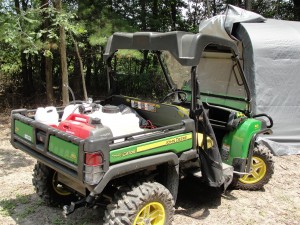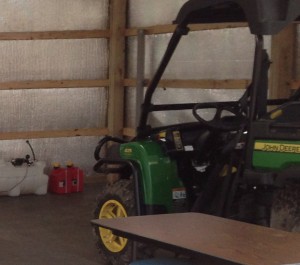I had always envisioned having permanent electric power delivered to the shed.
This would make many projects a lot easier. I had a small, portable gasoline generator (Honda), that could deliver 2,000 Watts whenever I had it powered up. I intended to use it in the back of the Gator, to drive various electric-powered tools. But I could also use it for power within the shed. The only catch was that because of its’ exhaust, I needed to place it outside the shed when it was running, to prevent carbon monoxide poisoning.

But 2,000 Watts is not actually that much power, depending on what your interests are. When I was trying to paint my wall panels in 40 degree weather, I had two space heaters working, and that was the limit. I could use only a single space heater, and have some left-over electricity for a light, but then it was colder. I wanted more power.
After asking around and looking at ads in the local paper, I found a small local company that did electrical contracting. The main guy met me at the woods one morning.
“I want to bring electricity into the shed, and I need your advice on how best to do this.” I said.
“How much power do you need? Is this for occasional use, or are you planning on running a lot of equipment or heating or drying things out?”
“Just occasional, lightweight use.”
I showed him the shed, and we took time off to go on a Gator ride around the property. When we returned to the shed, he told me:
“First, contact the power company and ask them to run a line to a pole in your property. The main power line is just across the street, so it won’t be difficult for them. They also have a pole already on the edge of your property, to help support the main power line.”

When I had built the shed, I had the construction guys put a 4 inch PVC pipe down through the concrete floor, and extending outside the shed. This was to place utilities, in the event I decided to bring in electricity.
“Once they get it to the pole, I’ll come out and run a trench from your pole to the PVC pipe at the shed. We’ll run buried cable through the trench, so if a tree or branch falls down, it won’t interrupt your power.”
“Inside the shed, I’d recommend plug-in boxes every 8 feet or so, attached to the upright poles. for lighting, we could go with fluorescent, but I’d suggest just simple incandescent bulbs, which are a lot easier to replace, particularly since you won’t be using them all the time.”
“Also, if you plan on working inside during the summer, a ceiling fan is an inexpensive, durable way to provide some cooling.”
“Outside, I’d recommend a couple of floodlights at each corner of the shed, so it is easy for you to work at night. And also a motion-sensor flood light at the front of the shed, in part to scare away bad guys, and in part to give you some automatic light if you just pull your car close to it.”
I liked everything he said and gave the go-ahead. Next stop, the power company.
